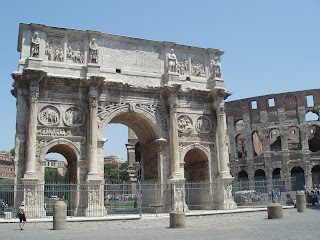 Saturday, July 21
Saturday, July 21This was another packed day (and really hot!). Look for dehydrated pictures on the blog.
We started by going to St. Peter in the Chains church. This was another new experience for me and I'm so glad we went. The most beautiful sculpture by Michaelangelo (and his personal favorite) was there. "Moses" was a gorgeous and detailed piece that took him 30 years of on-off work to finish. It looked like Moses had horns, but they said that centuries ago, the Hebrew word for "rays" was mistranslated as "horns." Oops! :) There were also two unfinished sculptures by M. of "Rachel" and "Leah."
The Arch of Constantine was our first stop. (It instantly makes me think of my years in crew as my coach, Keith Jefferson, would tell us the story of this battle every year. They symbol we wore on our uniforms was the shield with the cross.) In 312 A.D. Emperor Constantine defeated emperor Maxentius to unify Italy during the Battle of the Milvian Bridge. Constantine was hugely outnumbered and the night before the battle he saw a vision of a cross in the sky. He had all of his troops put this symbol on their shields. The next day, his well-trained, and blessed-perhaps? troops defeated Maxentius. Of course, it was after his becoming emperor that Christianity was legalized. The story, and seeing the arch, still gives me goosebumps.
We then headed to Palantine Hill above the Forum (another new experience). It has the remains of the imperial palaces. We get our word "palace" from this hill where the emperors chose to live. We looked over the edge to see the Circus Maximus which was the old chariot course. It was really long with tight turns on each end.
From there we went back down the hill to start the Forum walk. We started at the Arch of Titus which commemmorates the victory over Judea (Israel) in 70 A.D. (I had studied that in BSF!) The Romans weren't kind because Israel wouldn't worship the emperor as a god. Rome defeated Israel, sacked their temple, and brought home around 50,000 Jewish slaves. They forced the Jews to build this arch and the Colosseum. Whoa!

Next we saw many more ruins. The Basilica of Constanine (hall of justice), Temple of Antoninus Pius and Faustina (built to honor his late wife), Temple of Julius Caeser (mound where Julius' body was burned after being stabbed to death by the senators and his adopted son Brutus), Basilica Aemilia (floor plan used for medieval Christian churches), the Curia (Senate house), Rostrum, Temple of Saturn, the Column of Phocas (608 A.D. gift from Byzantine empire to fallen Rome), 6 story high Arch of Septimius Severus in 203 A.D., and Caligula's Palace (evil emperor) all were certainly interesting. The Temple of Vesta and the House of the Vestal Virgins was something I had also heard about. They priestesses were chosen before the age of 10 and had to serve 30 years tending the sacred flame. They were honored by the Romans and even had their own box in the Colosseum opposite the Emperor. If a priestess served faithfully for 30 years, she was given a dowry to marry and had a statue built in her honor. If she was found to not be a virgin, she was strapped to a funeral car, paraded through the Forum and taken to a crypt. There she was given a loaf of bread and a lamp and buried alive. Harsh!
After finishing the Forum, we entered the Mammertine Prison. It is 2,500 years old, cistern-like prison. It supposedly once held St. Peter and Paul. Prisoners were lowered through a hole into the prison. There is a column there where Peter was chained, and a spring where water miraculously sprung up so that Peter could convert and baptise his jailers. Whether fact or fiction, the prison is real and it must be like a prison that would have housed many of the early church believers. It was very claustrophobic and the ceiling was only a few inches above my head.
We saw more bits and pieces. We walked to see the Trajan's Column, Market and Forum. We also saw the 4 maps that show the Roman Empire's expansion. It really is incredible to see how large it really became. We walked around the Victor Emmanuel Monument built to celebrate Italy's unification in 1870. Our last stop was the Colusseum. It still wowed me even though I've seen it before. It was built in 80 A.D. It's real name was the Flavian Amphitheater. It held gladiator contests and other spectacles with animals and people. This wasn't one of the arenas where Christians were killed from what I understood. It was huge just like a football stadium and would have been able to seat 50,000 fans. The floor was gone and you could see down into the cells where they kept various animals and people, etc.

Whew! With all the heat, we took our leave and later enjoyed our most extravagent meal of the trip. Jen will blog more on that. Hopefully the history lesson wasn't too dull (I do get really excited about this kind of stuff!).
No comments:
Post a Comment